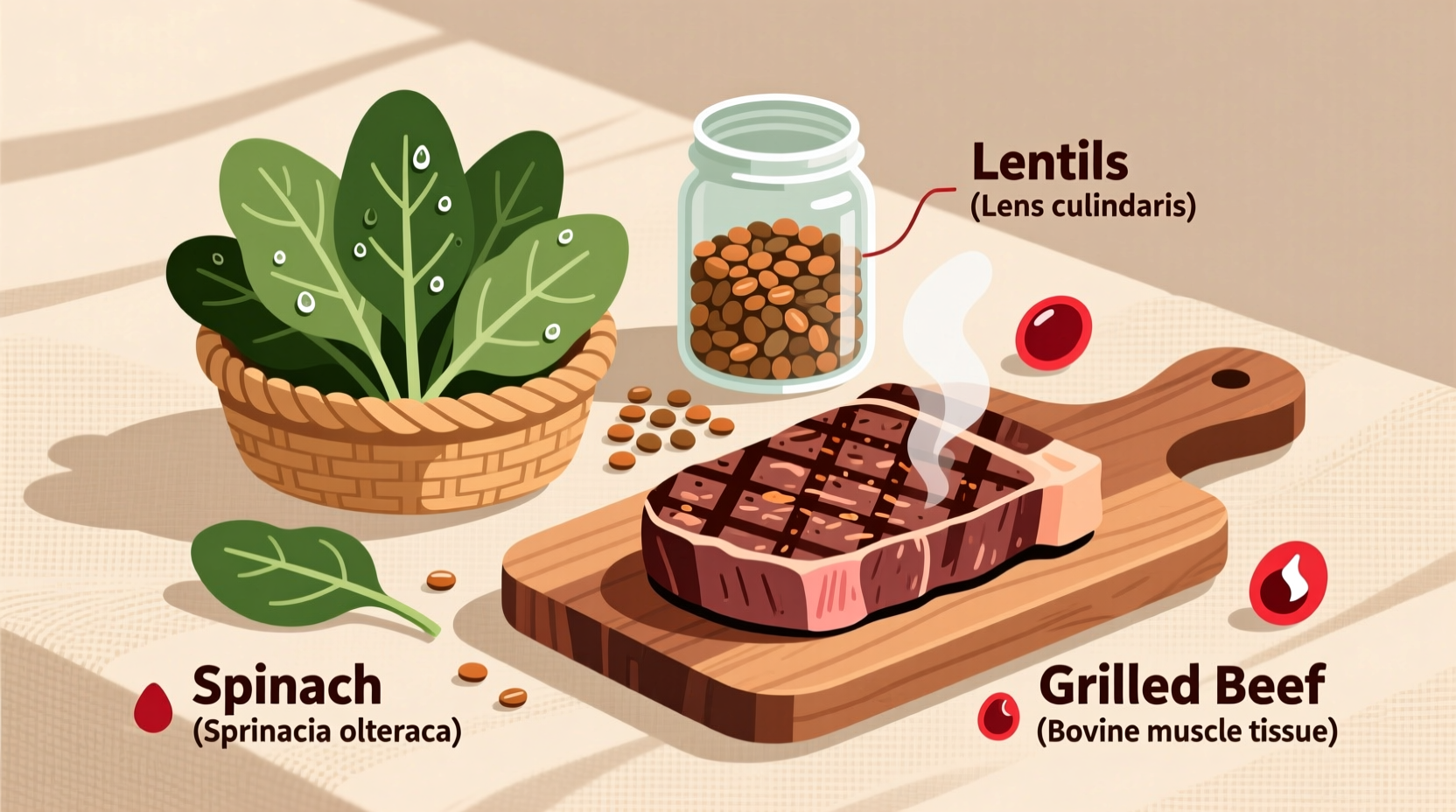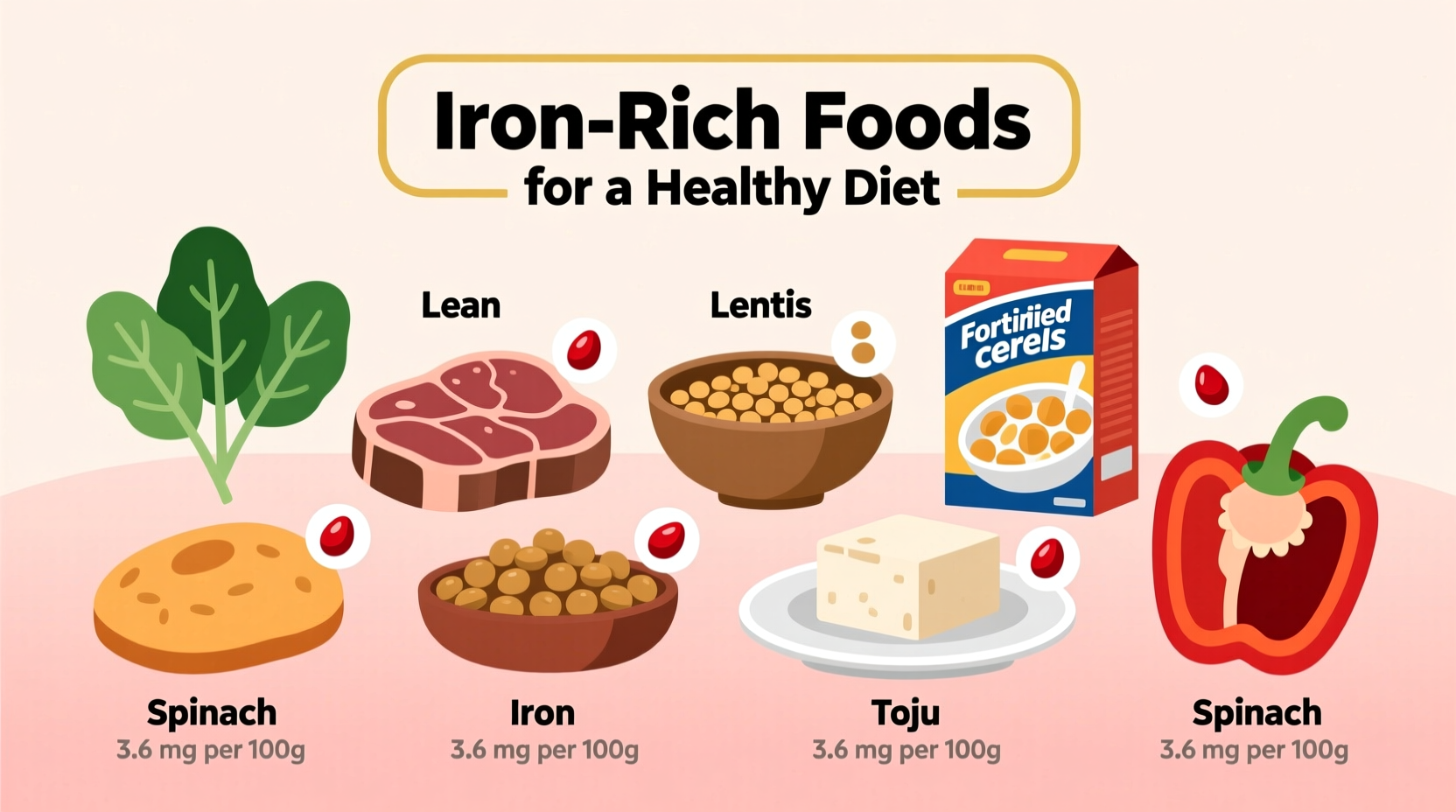Iron is essential for oxygen transport and energy production. The top iron-rich foods include red meat (3.5 oz provides 2.1-3.2 mg), organ meats like liver (3.5 oz provides 6.5 mg), shellfish (3 oz oysters contain 7.8 mg), legumes (1 cup lentils offer 6.6 mg), spinach (1 cup cooked provides 6.4 mg), and fortified cereals (up to 18 mg per serving). Heme iron from animal sources has 15-35% absorption versus 2-20% for plant-based non-heme iron. Pairing vitamin C-rich foods with iron sources can boost absorption by up to 300%.
Why Iron Matters More Than You Think
Iron deficiency affects over 1.6 billion people worldwide, making it the most common nutritional deficiency globally (World Health Organization, 2023). This essential mineral powers hemoglobin production, carries oxygen through your bloodstream, and fuels cellular energy metabolism. Without adequate iron, you might experience fatigue, weakened immunity, and cognitive challenges that impact daily life.
Your Iron Needs: Personalized Guidelines
Daily iron requirements vary significantly based on biological factors. The National Institutes of Health provides these evidence-based recommendations:
| Demographic Group | Daily Iron Requirement (mg) | Key Considerations |
|---|---|---|
| Men (19-50 years) | 8 | Requirements remain stable throughout adulthood |
| Women (19-50 years) | 18 | Menstruation increases needs; requirements double during pregnancy |
| Vegans/Vegetarians | 1.8x higher | Plant-based iron has lower absorption rates |
| Athletes | 15-25% higher | Increased red blood cell turnover and sweat losses |
Heme Iron Powerhouses: Animal-Based Sources
Heme iron from animal sources offers superior absorption (15-35%) compared to plant-based options. These foods deliver maximum iron bioavailability:
- Organ meats: Beef liver (3.5 oz = 6.5 mg) provides nearly 35% of daily needs in one serving. Chicken liver offers similar benefits with milder flavor.
- Shellfish: Oysters lead with 7.8 mg per 3 oz serving. Clams (3 oz = 3.4 mg) and mussels provide substantial amounts with heart-healthy omega-3s.
- Red meat: Grass-fed beef delivers 2.1-3.2 mg per 3.5 oz. Choose lean cuts like sirloin to balance iron intake with saturated fat considerations.
- Poultry: Dark meat turkey contains 1.4 mg per 3.5 oz, nearly double the iron in white meat.

Plant-Powered Iron: Maximizing Non-Heme Absorption
Plant-based iron (non-heme) has lower absorption rates (2-20%), but strategic food combinations dramatically improve uptake. These plant sources deliver impressive iron content when prepared correctly:
- Legumes: Lentils (1 cup cooked = 6.6 mg), chickpeas (1 cup = 4.7 mg), and white beans (1 cup = 3.9 mg) form the foundation of plant-based iron intake. Soaking and rinsing reduces phytates that inhibit absorption.
- Leafy greens: Spinach (1 cup cooked = 6.4 mg) and Swiss chard (1 cup cooked = 4 mg) provide substantial iron when consumed with vitamin C sources.
- Nuts and seeds: Pumpkin seeds (1 oz = 2.5 mg), sesame seeds (1 oz = 1.3 mg), and cashews (1 oz = 1.7 mg) make excellent snack options.
- Fortified foods: Many breakfast cereals contain 18 mg per serving (100% DV), while instant oatmeal packets often provide 10-11 mg.
The Absorption Advantage: What Really Works
Research from the American Journal of Clinical Nutrition reveals critical factors affecting iron absorption:
- Vitamin C boost: Adding 100 mg vitamin C (about 1 medium orange) to meals increases non-heme iron absorption by 300%. Try bell peppers with lentils or strawberries with fortified cereal.
- Avoid inhibitors at mealtime: Tea and coffee reduce absorption by 50-70% due to polyphenols. Wait 1-2 hours after meals before consuming these beverages.
- Cooking matters: Using cast iron cookware can increase iron content in foods by up to 1600%, particularly with acidic foods like tomato sauce.
- Strategic food pairings: Combining meat with plant sources (like beans in chili) improves overall iron absorption from the entire meal.
Dietary Considerations for Special Populations
Certain groups require tailored approaches to meet iron needs:
- Pregnant women need 27 mg daily. Focus on lean red meat, spinach salads with citrus dressing, and iron-fortified prenatal vitamins. The CDC reports that proper iron intake reduces preterm birth risk by 12%.
- Vegans and vegetarians should consume 1.8 times more iron than omnivores. Incorporate daily servings of legumes, dark leafy greens, and fortified foods while maximizing vitamin C pairings.
- Athletes experience increased iron loss through sweat and foot-strike hemolysis. Endurance athletes should monitor ferritin levels and consider adding 2-3 iron-rich meals weekly.
- Older adults face reduced absorption efficiency. Focus on heme iron sources and consider discussing supplementation with healthcare providers, as the National Institute on Aging notes absorption declines by 30% after age 65.
Practical Integration: Building Iron-Rich Meals
Transform your diet with these evidence-based strategies:
- Breakfast boost: Choose fortified cereal with sliced strawberries and pumpkin seeds instead of plain toast.
- Lunch transformation: Replace standard salads with spinach base, chickpeas, grilled chicken, bell peppers, and citrus vinaigrette.
- Dinner upgrade: Prepare lentil curry with tomatoes and serve with quinoa for a complete protein and iron package.
- Smart snacking: Keep roasted edamame and dried apricots (1 cup = 3.3 mg) for convenient iron-rich snacks.
When Food Isn't Enough: Recognizing Deficiency
While dietary sources should be primary, certain situations warrant medical attention. The American Society of Hematology identifies these red flags:
- Persistent fatigue despite adequate sleep
- Pale skin and brittle nails
- Shortness of breath during mild activity
- Unusual cravings for ice or non-food items (pica)
If you experience these symptoms, consult a healthcare provider for proper testing. Serum ferritin below 15 ng/mL indicates iron deficiency, while levels below 30 ng/mL may warrant dietary intervention even without full deficiency (Mayo Clinic Proceedings, 2022).











 浙公网安备
33010002000092号
浙公网安备
33010002000092号 浙B2-20120091-4
浙B2-20120091-4